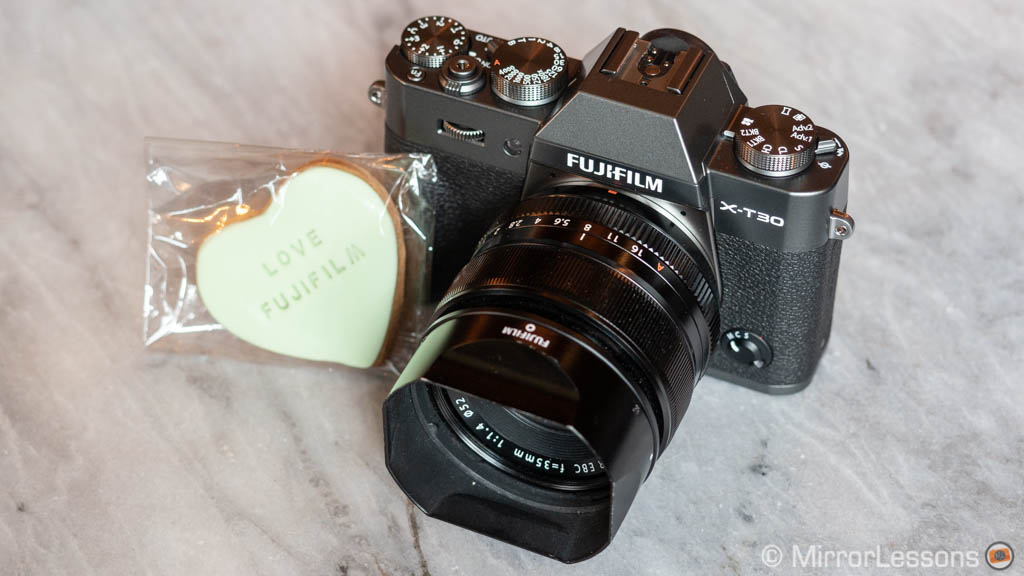The X-T30 is the third-generation model in Fujifilm’s mid-range selection.
One characteristic that makes this specific line-up popular is that despite the affordable price tag, the image quality and performance are on par with the flagship models.
We had the chance to play with a pre-production sample of this new APS-C camera. You can find our first impressions in the video below.
Ethics statement: We tested a pre-production X-T30 sample at a press event in London. Within the article, there are affiliate links. If you buy something after clicking one of these links, we will receive a small commission. To know more about our ethics, you can visit our full disclosure page. Thank you!
Video Review
Correction note: in the video below, at minute 2:55, I report that the camera has a remote input and that the USB-C port can be used to plug a microphone or headphone via an adapter.
That statement is incorrect: the 2.5mm remote input also serves as a microphone connection (you’ll need a 2.5mm to 3.5mm adapter in most cases) whereas the USB-C port can be used with a headphone (using an analog adapter).
Main Specs
- Sensor: 26.1 MP APS-C X-Trans IV CMOS
- Lens system: X-mount
- Weatherproof: None
- Internal Stabilisation: None
- Autofocus: Hybrid with up to 425 points (7×13 and 17×25 grids selectable)
- Continuous shooting: 8 fps, or up to 30fps with electronic shutter (AF-S and AF-C)
- ISO Sensitivity: 160 – 12800 ISO (pull 80, push up to 51200)
- Shutter Speeds: 1/4000 to 30 seconds, 1/32000s with electronic shutter
- Viewfinder: 0.39in OLED with 2,360k dots, approx. 100% FOV coverage, 17.5mm eyepoint, 0.62x magnification and 100fps refresh rate
- Rear monitor: tilting 3″ LCD (1.04M dots)
- Movie recording: 4K up to 30fps, Full HD up to 120fps
- Built-in Flash: Yes
- Extra Features: WiFi, Bluetooth, Pre-Shot, Panorama, Timelapse, Bracketing, Multiple exposure, Advanced filters
- Dimensions: 118.4 x 82.8 x 46.8 mm
- Weight: 383g (including battery and memory card)
Highlights
- Same sensor and processor as the Fujifilm X-T3
- Same 4K video quality as the X-T3 (no sensor crop, full pixel readout) minus the internal 10-bit recording. 10-bit 4:2:2 is possible via the HDMI output. Video is limited to 10min/clip in 4K, 15min/clip in 1080p
- High Frame Rate mode up to 120fps in Full HD
- Up to 20fps, or 30fps with a 1.25x crop with live view and no blackouts when using the electronic shutter
- New AF algorithm with improved Face and Eye tracking
- Same compact dimensions as the X-T20
- Most reactive touch screen to date among Fujifilm cameras
- Thinner LCD screen
- Same viewfinder as X-T20, but with a brighter panel and faster refresh rate (100Hz with boost mode)
- New charcoal color in addition to black and silver
Our Verdict
The X-T30 carries on the tradition of packing the same image quality and performance as the more advanced products into a smaller, lighter and less expensive package.
I don’t see why the X-T30 shouldn’t become as popular as its predecessor. You get excellent 4K video quality, better touch screen capabilities, an improved autofocus algorithm with better face and eye tracking, and fast continuous shooting speeds with no blackouts.
Could Fujifilm have done more with it? Well, perhaps the possibility to flip the screen out 180 degrees would have been a positive option for V-Loggers, and the 10 minute limitation per clip in 4K could have been lifted. Also, if you plan to get this camera for video, you’ll certainly need some spare batteries and some stabilised lenses.
These small considerations aside, there’s no question the X-T30 is a powerful mirrorless camera.
